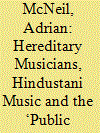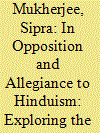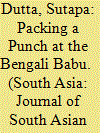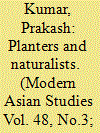|
|
|
Sort Order |
|
|
|
Items / Page
|
|
|
|
|
|
|
| Srl | Item |
| 1 |
ID:
119706


|
|
|
|
|
| Publication |
2013.
|
| Summary/Abstract |
Desiring to "engender" the written history of the Communist Party of India (CPI) and the movements it led or initiated, the author looks at the first generation of middle-class women who became communists in colonial Bengal in the period 1939 to 1948. Judging that much of the available printed and archival source material inadequately describes the role of women in the CPI, the author interviewed many of the surviving women CPI recruits and studied their printed memoirs. She examines in particular two organizations that were established in the late 1930s and early 1940s, namely, the Chhatri Sangha (Girl Students' Association) and the Mahila Atma Raksha Samity (Women's Self-Defense Association). The author contends that the recruiting and mobilizing strategies of the CPI-while focused primarily on class-also had important consequences for gender relations: many middle-class women found themselves transgressing the narrowly constructed norms of propriety and mixing with women of lower classes and working in public spaces together with men in ways the existing nationalist feminisms/nationalist conceptions of women's public activism had not made available. The author concludes that these revelations show the need to rethink stereotypes about the communist women, stereotypes built from the experiences of new generations of feminists in the 1960s and 1970s, but which seem not to have been as rigidly created or enforced in the 1940s as they were later on.
|
|
|
|
|
|
|
|
|
|
|
|
|
|
|
|
| 2 |
ID:
193287


|
|
|
|
|
| Summary/Abstract |
Although many commentators believed that caste did not matter in West Bengal, in recent years it has emerged as a significant factor in electoral politics. The decline of the Left and the rise of the centrist-incumbent have fanned identity politics and the resurgence of caste-based political mobilisation. In this conversation, Sekhar Bandyopadhyay, a well-known expert in the history and politics of caste in Bengal, illuminates the complexities, uniqueness and dynamics of caste politics in colonial Bengal and contemporary West Bengal. The interview explores the evolution of the caste-system in colonial Bengal, its differences with the rest of India and the multiple manifestations of caste-based politics in contemporary West Bengal. Bandyopadhyay reflects on the intersection of caste with other categories of class and religion, the lower-castes’ involvement, appropriation and neglect in the political spectrum, and the future of caste and politics in West Bengal.
|
|
|
|
|
|
|
|
|
|
|
|
|
|
|
|
| 3 |
ID:
175482


|
|
|
|
|
| Summary/Abstract |
Pioneering women’s periodicals in Bengali in the second half of the nineteenth century eloquently deplore the social confinement of women. Contesting this paradigm of female immobility, travelogues written by Bengali women simultaneously start to appear in the pages of such journals as Bāmābodhinıī Patrikā, Bhāratıī, Antaḥpur, etc., from the 1860s onwards. Unlike the famous nineteenth-century Bengali travelogues by Krishnabhabini Das and Svarnakumari Debi, these other writings have only very recently drawn attention. After laying out the state of the art, I will first introduce two of the established travelogues. Thereafter I will look at these still largely unknown writings, measure their significance for a women’s public and the Bengali literary sphere, and evaluate their setting in terms of gender and class. Shorter and less spectacular, the accounts in these periodicals are nonetheless a significant body of literature. They furnish detailed insights into the travel conditions and social framework women in those days experienced, and amply bear witness to the literary sentiments travelling inspired.
|
|
|
|
|
|
|
|
|
|
|
|
|
|
|
|
| 4 |
ID:
159384


|
|
|
|
|
| Summary/Abstract |
In the late nineteenth century, Hindustani music and its culture arrived in Calcutta's public sphere. It was carried there as much through the migration and agency of the professional lives of the ‘ustads from the North’ as it was through the forces of coloniality, modernity and Hindu nationalism. On its arrival, the performance practice and social organisation of Hindustani music culture came face to face with the bustle of social and cultural experimentation and innovation that came to define the ‘Bengal Renaissance’. Hindustani music was certainly not isolated from this larger cultural dynamic and, over four or five decades, its practitioners were compelled to formulate a series of responses in order to negotiate the challenges which this public sphere posed to past practices of this tradition transplanted from North India to Bengal. Their responses bring into focus a number of significant issues: firstly, the nature of these responses and the consequences they had for the development of Hindustani music and its culture; secondly, the issue of the discourse of ‘modern’ Hindustani music that arose from this encounter; and thirdly, questions over whose voice(s) were represented and whose voice(s) were marginalised in the process. Finally, there is the issue of how these responses still resonate in Hindustani music practice today, as they continue to reside in and frame the contemporary musical imagination.
|
|
|
|
|
|
|
|
|
|
|
|
|
|
|
|
| 5 |
ID:
159392


|
|
|
|
|
| Summary/Abstract |
The article studies the Bangla hagiography of Harichand Thakur, the founder of the Matua sampraday, a sect that broke away from Brahmanical Hinduism in nineteenth-century Bengal. The paper explores how the hagiography takes on the added task of constructing the collective identity of the Matuas. It argues that for a vulnerable and marginalised community where the hagiography is among the few books published, the text serves to validate the community's aspirations and authenticates its legacy. The sect, founded in opposition to the dominant Brahmanical hegemony that had kept them suppressed for generations, has been an upwardly mobile community in the twentieth century. The essay examines the changing presentations of the hagiography over a century to explore how the Matua community walks a fine line between opposition and allegiance to the majoritarian Hindu faith, and how the indeterminate boundaries between myth and history, fact and fiction, are used in this project of the community's self-construction.
|
|
|
|
|
|
|
|
|
|
|
|
|
|
|
|
| 6 |
ID:
179987


|
|
|
|
|
| Summary/Abstract |
The emergence of the bhadralok in the nineteenth century, typified by ‘genteel’ qualities and Western education, reflected changes in the nature of Bengali identity and subjectivity. The colonial experience resulted in an anxiety among elite Bengalis to define a social class for themselves that would delineate their gentility and shape a new code of ‘acceptability’. The ‘Babu’ came to be associated with this new class of Bengalis eager to adopt Western manners and learning who formed the greater part of the white-collar workers required in the cosmopolitan enclave of Calcutta. They were satirised, particularly in colonial discourse, for their imitation of English manners, attire and language. This article explores the shifting markers of gentility and the satiric representation of the Bengali Babu (and his Bibi) in the British satirical magazine, Punch, and its contemporary vernacular counterparts in colonial Bengal.
|
|
|
|
|
|
|
|
|
|
|
|
|
|
|
|
| 7 |
ID:
131806


|
|
|
|
|
| Publication |
2014.
|
| Summary/Abstract |
The knowledge of indigo culture that developed on indigo plantations in colonial Bengal was remarkably cosmopolitan in its borrowings. The protean knowledge that was assembled in the first plantations in the Caribbean in the mid-seventeenth century had roots in various peasant traditions on the Indian subcontinent and elsewhere in the world. French naturalists committed this knowledge to texts, making them legible and portable whilst the needs of European empires ensured the perfection of this knowledge on separate continents even as it picked up heterogeneous forms at numerous sites. The heterogeneity of the knowledge attached to the practice of indigo manufacture was reproduced on the Indian subcontinent when indigo was reinvented as a colonial commodity. European planters generously drew on the texts describing indigo-making that were easily available, as the practice of dye making continued to evolve in the colonial locality. Some surviving peasant traditions of indigo culture on the subcontinent also impinged on the evolving knowledge. Thus multiple logics rather than the single colonial logic lay beneath the development of colonial indigo plantations in Bengal. An understanding of the process requires attention to the global genealogies of this knowledge system.
|
|
|
|
|
|
|
|
|
|
|
|
|
|
|
|
|
|
|
|
|